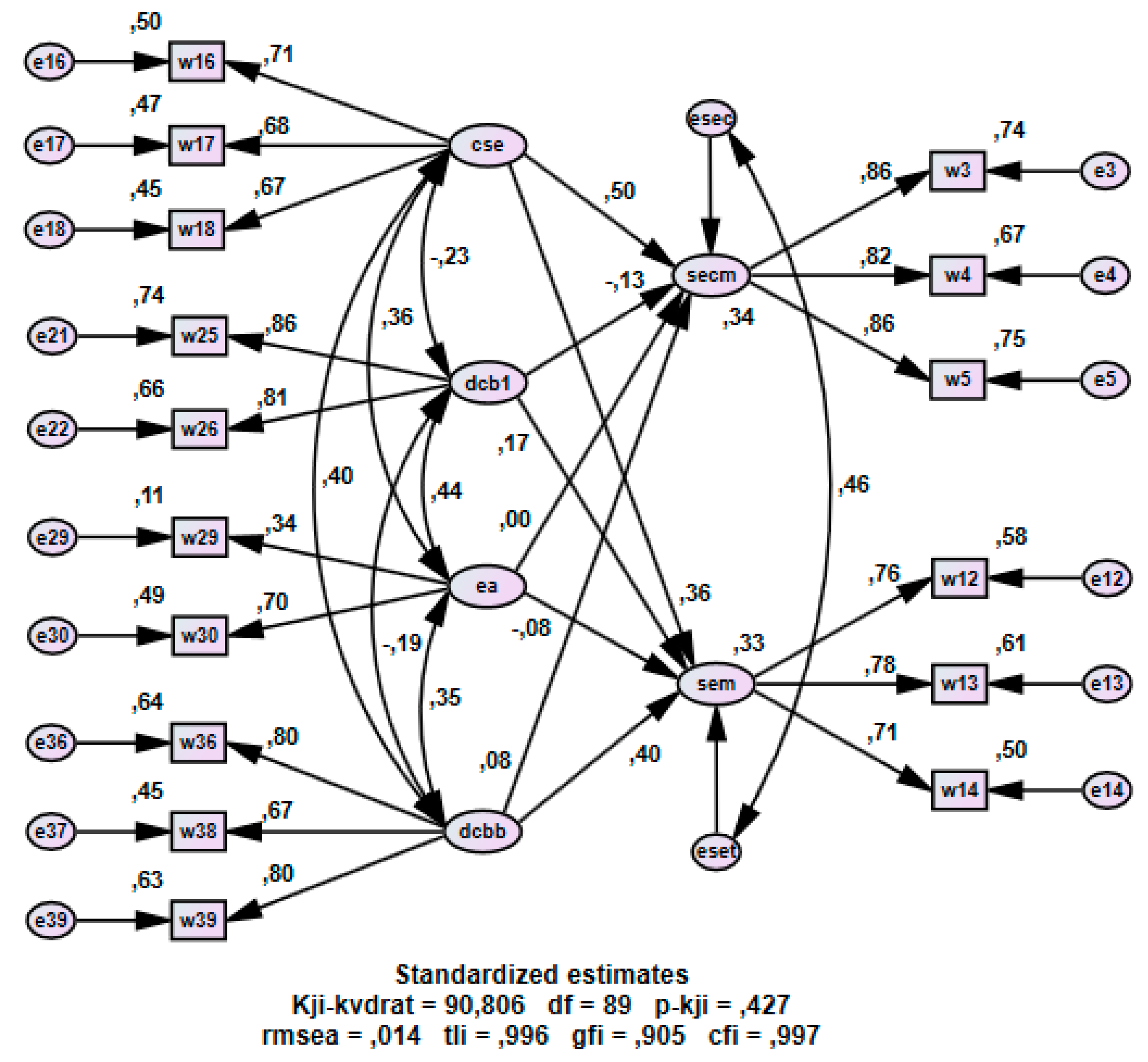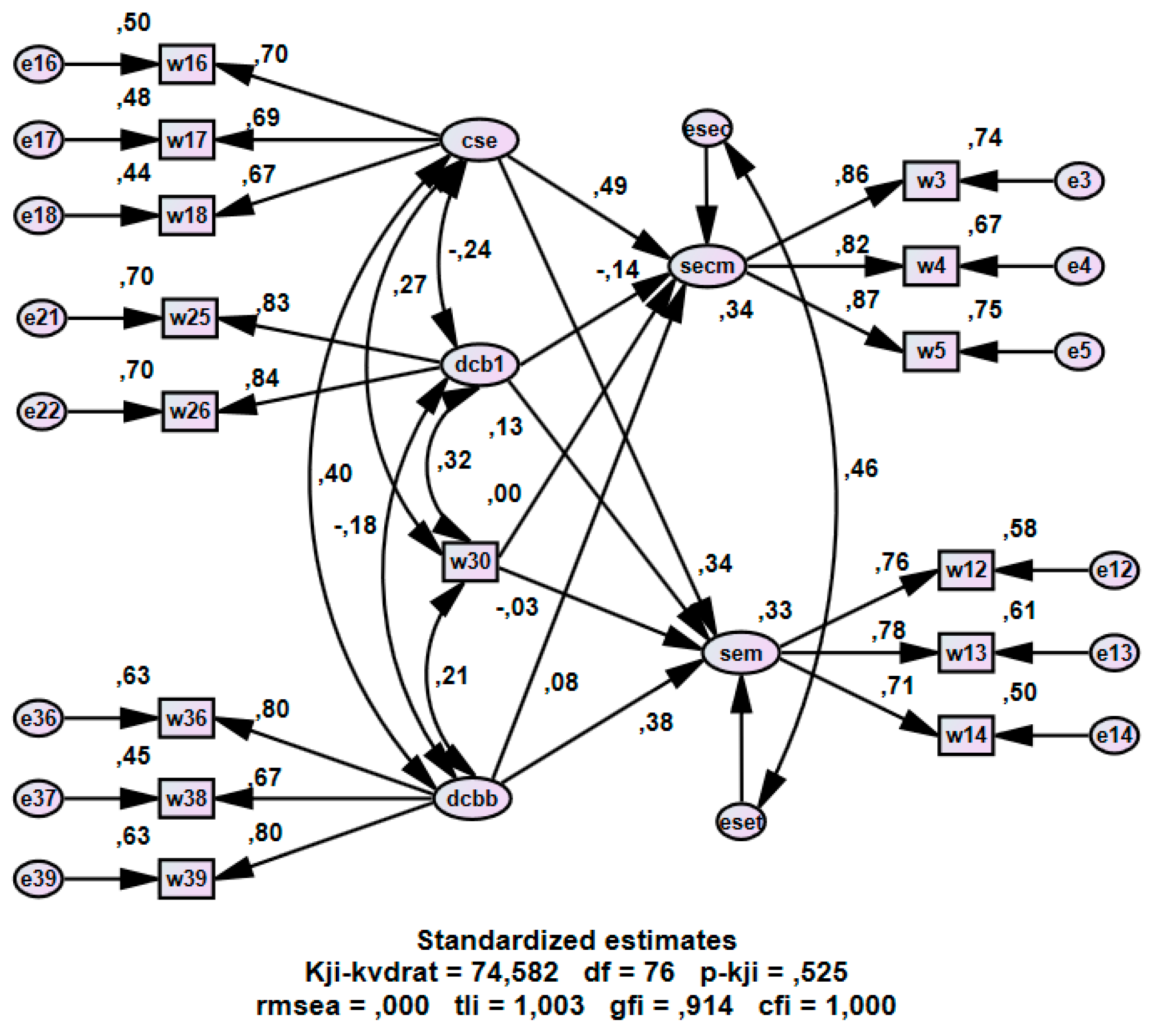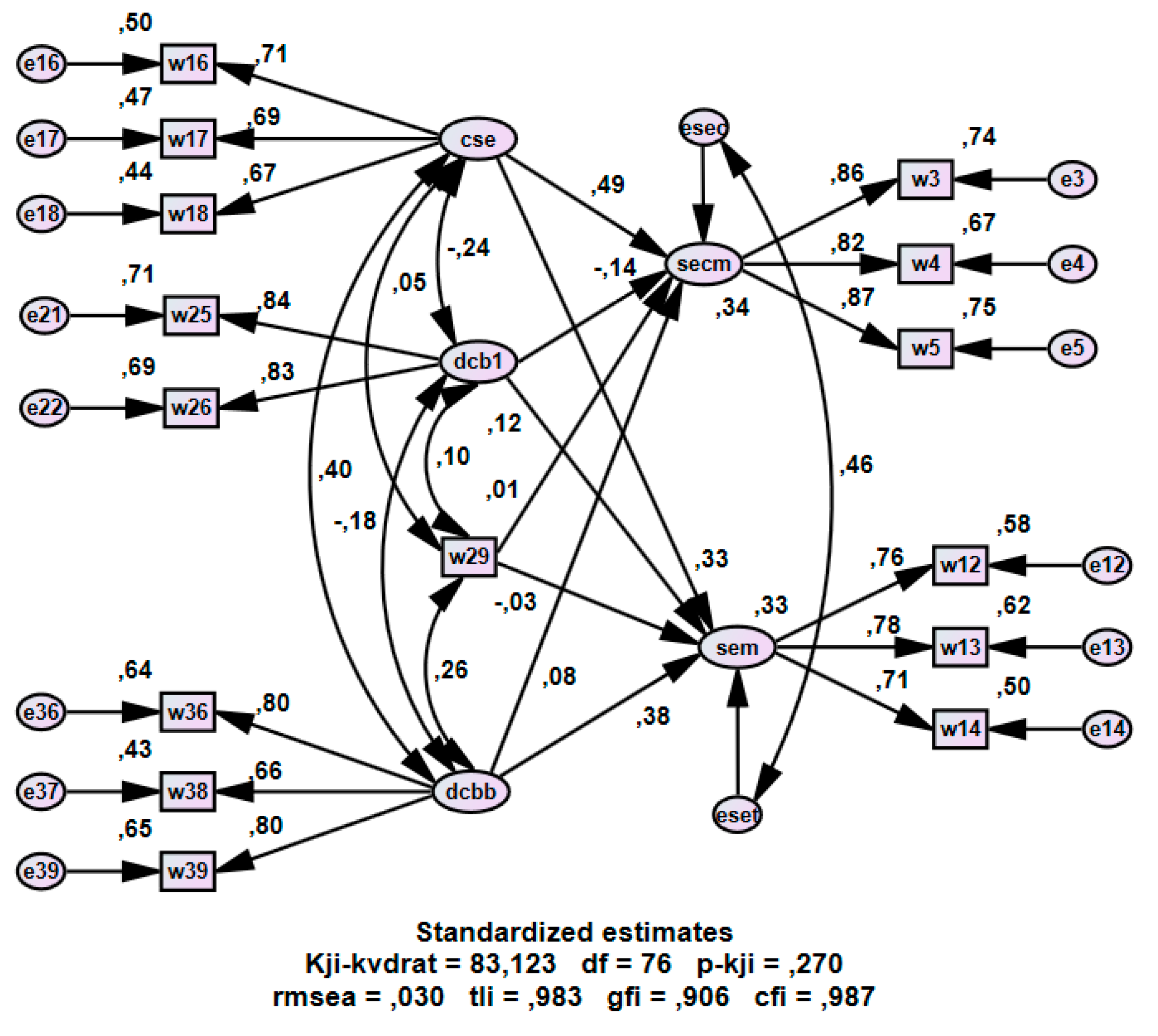Perceptions of Digital Competency among Student Teachers: Contributing to the Development of Student Teachers’ Instructional Self-Efficacy in Technology-Rich Classrooms
Abstract
:1. Introduction
2. The Context
2.1. Theoretical Framework
2.2. Methods
3. Participants
4. Data Sources
‘Imagine that you have been given a temporary job as a teacher at a school. The school leadership has determined that each student should have his or her own computer with an Internet connection and unrestricted Internet access during your lessons.’
- Self-Efficacy for Maintaining Discipline (Secm), α = 0.89
- How certain are you that you can:
- persuade even the most gaming-interested students to concentrate on school-related tasks? (Item No. w3)
- persuade students who often switch among different social media to follow classroom rules? (w4)
- persuade all students to concentrate on educational tasks without being disturbed by other Internet-based material? (w5)
- Self-Efficacy for Influencing Students’ Use of ICT in the Service of Learning (Sem), α = 0.79
- Using digital aids, to what extent can you motivate students to have a real desire to learn? (w12)
- To what extent can you persuade students to believe that they can learn better by employing digital learning resources? (w13)
- To what extent can you persuade students to work hard with curriculum materials when they are using digital resources? (w14)
- Prospective Perceptions of Digital Competency to Resolve Challenges Relating to ICT in Schools (Cse), α = 0.72
- At this school, the teachers:
- effectively prevent digital bullying on school premises. (w16)
- handle any problems that arise with ICT as a learning resource because we work as a team. (w17)
- create a safe atmosphere even in the most challenging classes. (w18)
- Constraint Factors: Perceptions of Student Self-Determination in Using ICT (Dcb1), α = 0.82
- The amount that students learn at school by using ICT is determined primarily by their motivation. (w25)
- The amount that students learn at school by using ICT is determined primarily by their self-discipline. (w26)
- Vicarious Experience Understood as Enactive Attainment (Ea), α = 0.38
- To what extent have you gained experience during teaching-practice periods with teaching resources containing pictures, illustrations, video clips, animations and audio fragments? (w29)
- To what extent have you gained knowledge through the teacher-training course about teaching resources containing pictures, illustrations, video clips, animations and audio fragments? (w30)
- Attitudes Towards Digital Skills (Dcbb), α = 0.79
- The focus on digital skills in this school has contributed to reinforcing students’ academic learning. (w36)
- The focus on digital skills in this school has resulted in appropriate contemporary education. (w38)
- The focus on digital skills in this school has been a deviation (reversed). (w39)
4.1. Results
4.2. Discussion
4.3. Implications for Further Research
4.4. Study Limitations
5. Conclusions
Acknowledgments
Author Contributions
Conflicts of Interest
References
- Ministry of Education. Strategy: The Teacher Promotion. Pulling towards Knowledge in School; Ministry of Education: Oslo, Norway, 2014.
- Lid, S.E. PPUs Relevans for Undervisning i Skolen. En Kartlegging av Studenters og Nyutdannede Læreres Oppfatninger (The Relevance of Practical-Pedagogical Training. A Mapping of Student Teachers’ and Newly Qualified Teachers’ Perceptions); NOKUTs utredninger og analyser: Oslo, Norway, 2013. [Google Scholar]
- Hatlevik, O.E.; Egeberg, G.; Gudmundsdottir, G.B.; Loftsgaarden, M.; Loi, M. Monitor Skole 2013: Om Digital Kompetanse og erFaringer Med Bruk av IKT i Skolen (Monitor School. On Digital Competence and Experience with ICT in Schools); Senter for IKT i Utdanningen: Oslo, Norway, 2013. [Google Scholar]
- Tondeur, J.; van Braak, J.; Sang, G.; Voogt, J.; Fisser, P.; Ottenbreit-Leftwich, A. Preparing preservice teachers to integrate technology in education: A synthesis of qualitative evidence. Comput. Educ. 2012, 59, 134–144. [Google Scholar] [CrossRef]
- Koehler, M.J.; Mishra, P. What is technological pedagogical content knowledge? Contemp. Issues Technol. Teach. Educ. 2009, 9, 60–70. [Google Scholar]
- Johannesen, M.; Øgrim, L.; Giæver, T.H. Notion in motion: Teachers’ digital competence. Nord. J. Digit. Lit. 2014, 9, 300–312. [Google Scholar]
- Lund, A.; Furberg, A.; Bakken, J.; Engelien, K.L. What does professional digital competence mean in teacher education? Nord. J. Digit. Lit. 2014, 9, 281–299. [Google Scholar]
- Griffin, P.; McGaw, B.; Care, E. Assessment and Teaching of 21st Century Skills; Springer: Dordrecht, The Netherlands, 2012. [Google Scholar]
- Calderhead, J. The nature and growth of knowledge in student teaching. Teach. Teach. Educ. 1991, 7, 531–536. [Google Scholar] [CrossRef]
- Ottestad, G.; Kelentric, M.; Gudmundsdottir, G.B. Professional digital competence in teacher education. Nord. J. Digit. Lit. 2014, 9, 243–249. [Google Scholar]
- Elstad, E. Building self-discipline to promote learning: Students’ volitional strategies to navigate the demands of schooling. Learn. Inq. 2008, 2, 53–71. [Google Scholar] [CrossRef]
- Blikstad-Balas, M. Digital literacy in upper secondary school—What do students use their laptops for during teacher instruction? Nord. J. Digit. Lit. 2012, 7, 81–96. [Google Scholar]
- Ottenbreit-Leftwich, A.; Glazewski, K.; Newby, T.; Ertmer, P. Teacher value beliefs associated with using technology: Addressing professional and student needs. Comput. Educ. 2010, 55, 1321–1335. [Google Scholar] [CrossRef]
- Valcke, M.; Rots, I.; Verbeke, M.; van Braak, J. ICT teacher training: Evaluation of the curriculum and training approach in Flanders. Teach. Teach. Educ. Int. J. Res. Stud. 2007, 23, 795–808. [Google Scholar] [CrossRef]
- Klassen, R.M.; Chiu, M.M. Effects on teachers’ self-efficacy and job satisfaction: Teacher gender, years of experience, and job stress. J. Educ. Psychol. 2010, 102, 741–756. [Google Scholar] [CrossRef]
- Rivkin, S.G.; Hanushek, E.A.; Kain, J.F. Teachers, schools, and academic achievement. Econometrica 2005, 73, 417–458. [Google Scholar] [CrossRef]
- Boyd, D.; Lankford, H.; Loeb, S.; Rockoff, J.; Wyckoff, J. The narrowing gap in New York City teacher qualifications and its implications for student achievement in high-poverty schools. J. Policy Anal. Manag. 2008, 27, 793–818. [Google Scholar] [CrossRef]
- Struyven, K.; Vanthournout, G. Teachers’ exit decisions: An investigation into the reasons why newly qualified teachers fail to enter the teaching profession or why those who do enter do not continue teaching. Teach. Teach. Educ. 2014, 43, 37–45. [Google Scholar] [CrossRef]
- Tiplic, D.; Brandmo, C.; Elstad, E. Antecedents of Norwegian Beginning Teachers’ Turnover Intentions. Camb. J. Educ. 2015, 45, 451–474. [Google Scholar] [CrossRef]
- Skaalvik, E.M.; Skaalvik, S. Dimensions of teacher self-efficacy and relations with strain factors, perceived collective teacher efficacy, and teacher burnout. J. Educ. Psychol. 2007, 99, 611–625. [Google Scholar] [CrossRef]
- Darling-Hammond, L.; Lieberman, A. Teacher Education around the World: Changing Policies and Practices; Routledge: New York, NY, USA, 2012. [Google Scholar]
- Martinussen, G.; Smestad, B. Allmennlærerstudenters arbeidsinnsats: Bedre enn sitt rykte (Student teachers’ effort: Better than the rumour)? In FoU i Praksis; Hoel, T.L., Guldal, T.M., Dons, C.F., Sagberg, S., Solhaug, T., Wæge, K., Eds.; Tapir: Trondheim, Norway, 2011; pp. 331–340. [Google Scholar]
- Joram, E. Clashing epistemologies: Aspiring teachers’, practicing teachers’, and professors’ beliefs about knowledge and research in education. Teach. Teach. Educ. 2007, 23, 123–135. [Google Scholar] [CrossRef]
- Kern, D.E. Curriculum Development for Medical Education: A Six-Step Approach; JHU Press: New York, NY, USA, 1998. [Google Scholar]
- Tillema, H.H.; Smith, K.; Leshem, S. Dual roles–conflicting purposes: A comparative study on perceptions on assessment in mentoring relations during practicum. Eur. J. Teach. Educ. 2011, 34, 139–159. [Google Scholar] [CrossRef]
- Gunnes, T.; Knudsen, P. Tilbud og Etterspørsel for Ulike Typer Lærere Mot 2040 (Supply and Demand of Different Types of Teachers towards 2040); Report no.41; Statistics Norway: Oslo, Norway, 2015. [Google Scholar]
- Bandura, A. Self-efficacy: Toward a unifying theory of behavioral changes. Psychol. Rev. 1977, 84, 191–215. [Google Scholar] [CrossRef] [PubMed]
- Albion, P.R. Some factors in the development of self-efficacy beliefs for computer use among teacher education students. J. Technol. Teach. Educ. 2001, 9, 321–348. [Google Scholar]
- Guskey, T.R. Teacher efficacy, self-concept, and attitudes toward the implementation of instructional innovation. Teach. Teach. Educ. 1988, 4, 63–69. [Google Scholar] [CrossRef]
- European Commission. Key Competences for Lifelong Learning. European Reference Framework; Office for Official Publications of the European Communities: Luxembourg, 2007. [Google Scholar]
- Vedeler, M. Slakter Lektorpraksisen Ved UiO, Universitas, 2010 (Butchering the teacher training at the University of Oslo). Available online: http://universitas.no/nyhet/55205/slakter-lektorpraksisen-ved-uio/hl:l%E6rerutdanning (accessed on 29 May 2014).
- Imsen, G. Elevens Verden (The Student’s World), 4th ed.; Universitetsforlaget: Oslo, Norway, 2010. [Google Scholar]
- Dicke, T.; Parker, P.D.; Marsh, H.W.; Kunter, M.; Schmeck, A.; Leutner, D. Self-efficacy in classroom management, classroom disturbances, and emotional exhaustion: A moderated mediation analysis of teacher candidates. J. Educ. Psychol. 2014, 106, 1–15. [Google Scholar] [CrossRef]
- Kraut, R.; Chandler, T.; Hertenstein, K. The Interplay of Teacher Training, Access to Resources, Years of Experience and Professional Development in Tertiary ESL Reading Teachers’ Perceived Self-Efficacy. GIST Educ. Learn. Res. J. 2016, 12, 132–151. [Google Scholar]
- Valtonen, T.; Kukkonen, J.; Kontkanen, S.; Sormunen, K.; Dillon, P.; Sointu, E. The impact of authentic learning experiences with ICT on pre-service teachers’ intentions to use ICT for teaching and learning. Comput. Educ. 2015, 81, 49–58. [Google Scholar] [CrossRef]
- Rohatgi, A.; Scherer, R.; Hatlevik, O.E. The role of ICT self-efficacy for students’ ICT use and their achievement in a computer and information literacy test. Comput. Educ. 2016, 102, 103–116. [Google Scholar] [CrossRef]
- Goddard, R.D.; Hoy, W.K.; Hoy, A.W. Collective teacher efficacy: Its meaning, measure, and impact on student achievement. Am. Educ. Res. J. 2000, 37, 479–507. [Google Scholar] [CrossRef]
- Elstad, E. Why is there a wedge between the promise of educational technology and the experiences of a technology-rich pioneer school? In Digital Expectations and Experiences in Education; Elstad, E., Ed.; Sense Publishers: Rotterdam, The Netherlands, 2016; pp. 77–96. [Google Scholar]
- Christophersen, K.A.; Elstad, E.; Solhaug, T.; Turmo, A. Explaining Motivational Antecedents of Citizenship Behavior among Preservice Teachers. Educ. Sci. 2015, 5, 126–145. [Google Scholar] [CrossRef]
- Elstad, E. Understanding the nature of accountability failures in the technology-filled classroom: Disaffected students and teachers who give in. J. Curric. Stud. 2006, 38, 459–481. [Google Scholar] [CrossRef]
- Fraillon, J.; Ainley, J.; Schulz, W.; Friedman, T.; Gebhardt, E. Preparing for life in a digital age: The IEA International Computer and Information Literacy Study. International Report; Springer: Cham, Switzerland, 2014. [Google Scholar]
- Fuller, F.F.; Bown, O.H. Becoming a Teacher; National Society for the Study of Education: Chicago, IL, USA, 1975. [Google Scholar]
- Leinhardt, G.; Greeno, J.G. The cognitive skill of teaching. J. Educ. Psychol. 1986, 78, 75–86. [Google Scholar] [CrossRef]
- Anderson, J.R. Acquisition of cognitive skill. Psychol. Rev. 1982, 89, 369–403. [Google Scholar] [CrossRef]
- Greeno, J. Instructional representations based on research about understanding. In Cognitive Science and Mathematics Education; Schoenfeld, A.H., Ed.; Erlbaum: Hillsdale, MI, USA, 1987; pp. 61–88. [Google Scholar]
- Park, S.; Oliver, J.S. Revisiting the conceptualisation of pedagogical content knowledge (PCK): PCK as a conceptual tool to understand teachers as professionals. Res. Sci. Educ. 2008, 38, 261–284. [Google Scholar] [CrossRef]
- Ophir, E.; Nass, C.; Wagner, A.D. Cognitive control in media multitaskers. Proc. Natl. Acad. Sci. USA 2009, 106, 15583–15587. [Google Scholar] [CrossRef] [PubMed]
- Elstad, E.; Arnesen, T.; Christophersen, K.A. What explains pupils’ perceived motivational conflict between academic work and off-task behaviour in technology-rich classrooms? In Digital Expectations and Experiences in Education; Elstad, E., Ed.; Sense Publishers: Rotterdam, The Netherlands, 2016; pp. 59–75. [Google Scholar]
- Eble, K.E. The Craft of Teaching: A Guide to Mastering the Professor’s Art; Jossey-Bass Publishers: San Francisco, CA, USA, 1988. [Google Scholar]
- Yang, Y.T.C.; Wu, W.C.I. Digital storytelling for enhancing student academic achievement, critical thinking, and learning motivation: A year-long experimental study. Comput. Educ. 2012, 59, 339–352. [Google Scholar] [CrossRef]
- Skaalvik, E.M.; Skaalvik, S. Teacher self-efficacy and teacher burnout: A study of relations. Teach. Teach. Educ. 2010, 26, 1059–1069. [Google Scholar] [CrossRef]
- Chai, C.S.; Koh, J.H. L.; Tsai, C.C.; Tan, L.L. W. Modeling primary school pre-service teachers’ technological pedagogical content knowledge (TPACK) for meaningful learning with information and communication technology (ICT). Comput. Educ. 2011, 57, 1184–1193. [Google Scholar] [CrossRef]
- Tondeur, J.; Aesaert, K.; Pynoo, B.; Braak, J.; Fraeyman, N.; Erstad, O. Developing a validated instrument to measure preservice teachers’ ICT competencies: Meeting the demands of the 21st century. Br. J. Educ. Technol. 2016, 1–11. [Google Scholar] [CrossRef] [Green Version]
- Kline, R.B. Principle and Practice of Structural Equation Modeling; The Guildford Press: New York, NY, USA, 2005. [Google Scholar]
- British Educational Research Association. The Role of Research in Teacher Education: Reviewing the Evidence; British Educational Research Association: London, UK, 2014. [Google Scholar]
- Koretz, D.M. Measuring up; Harvard University Press: Boston, MA, USA, 2008. [Google Scholar]
- Moolenaar, N.M. A social network perspective on teacher collaboration in schools: Theory, methodology, and applications. Am. J. Educ. 2012, 119, 7–39. [Google Scholar] [CrossRef]
- Sang, G.; Valcke, M.; van Braak, J.; Tondeur, J. Student teachers’ thinking processes and ICT integration: Predictors of prospective teaching behaviors with educational technology. Comput. Educ. 2010, 54, 103–112. [Google Scholar] [CrossRef]
- Lacey, C. The Socialization of Teachers; Routledge: London, UK, 2012. [Google Scholar]
- O’Neill, S.; Stephenson, J. Does classroom management coursework influence pre-service teachers’ perceived preparedness or confidence? Teach. Teach. Educ. 2012, 28, 1131–1143. [Google Scholar] [CrossRef]
- Røkenes, F.M.; Krumsvik, R.J. Development of Student Teachers’ Digital Competence in Teacher Education-A Literature Review. Nord. J. Digit. Lit. 2014, 9, 250–280. [Google Scholar]
- Bennett, S.; Maton, K.; Kervin, L. The ‘digital natives’ debate: A critical review of the evidence. Br. J. Educ. Technol. 2008, 39, 775–786. [Google Scholar] [CrossRef]



| Item | Minimum | Maximum | Mean | Std. Deviation | Skewness | Kurtosis |
|---|---|---|---|---|---|---|
| w3 | 1.00 | 6.00 | 3.24 | 1.46 | 0.20 | −0.88 |
| w4 | 1.00 | 7.00 | 3.63 | 1.47 | 0.00 | −0.76 |
| w5 | 1.00 | 6.00 | 3.13 | 1.46 | 0.26 | −0.85 |
| w12 | 1.00 | 7.00 | 5.02 | 1.10 | −0.85 | 2.46 |
| w13 | 1.00 | 7.00 | 4.64 | 1.25 | −0.41 | 0.49 |
| w14 | 1.00 | 7.00 | 4.39 | 1.10 | −0.30 | 0.04 |
| w16 | 1.00 | 7.00 | 3.43 | 1.46 | 0.37 | −0.18 |
| w17 | 1.00 | 7.00 | 4.42 | 1.36 | −0.15 | 0.11 |
| w18 | 1.00 | 7.00 | 4.45 | 1.16 | −0.30 | 0.01 |
| w25 | 1.00 | 7.00 | 4.63 | 1.41 | −0.35 | 0.06 |
| w26 | 1.00 | 7.00 | 4.95 | 1.44 | −0.52 | −0.05 |
| w29 | 1.00 | 7.00 | 5.77 | 1.27 | −1.55 | 2.69 |
| w30 | 1.00 | 7.00 | 4.28 | 1.48 | −0.29 | −0.75 |
| w36 | 1.00 | 7.00 | 4.23 | 1.13 | −0.18 | 0.51 |
| w38 | 1.00 | 7.00 | 5.04 | 1.37 | −0.78 | 0.46 |
| w39 | 1.00 | 7.00 | 5.19 | 1.62 | −0.81 | −0.23 |
| Hypothesis | Wording | Result |
|---|---|---|
| 1 | Vicarious experiences are positively related to instructional self-efficacy. | The associations between these variables in model 1 and model 2 are not significant and, thus, fail to support the hypothesis. |
| 2 | Positive attitudes are positively related to instructional self-efficacy. | The association (b(dcbb→sem) = 0.40) in model 1 is significant and supports the hypothesis; however, the association (b(dcbb→secm) = 0.08) is not significant. |
| 3 | Perception of digital competency among student teachers is positively related to instructional efficacy. | The association (b(cse→sem) = 0.36) in model 1 is significant and supports the hypothesis. The association (b(cse→secm) = 0.50) in model 1 is significant and supports the hypothesis. |
| 4 | Vicarious experiences are positively related to perceptions of digital competency among student teachers. | The associations (b(ea→secm) = −0.00) and (b(ea→sem) = −0.08) are not significant and do not support the hypothesis. |
| 5 | Constraint factors are negatively related to instructional efficacy. | The association between these variables in model 2 is not significant and, thus, fails to support the hypothesis. |
© 2017 by the authors; licensee MDPI, Basel, Switzerland. This article is an open access article distributed under the terms and conditions of the Creative Commons Attribution (CC BY) license ( http://creativecommons.org/licenses/by/4.0/).
Share and Cite
Elstad, E.; Christophersen, K.-A. Perceptions of Digital Competency among Student Teachers: Contributing to the Development of Student Teachers’ Instructional Self-Efficacy in Technology-Rich Classrooms. Educ. Sci. 2017, 7, 27. https://doi.org/10.3390/educsci7010027
Elstad E, Christophersen K-A. Perceptions of Digital Competency among Student Teachers: Contributing to the Development of Student Teachers’ Instructional Self-Efficacy in Technology-Rich Classrooms. Education Sciences. 2017; 7(1):27. https://doi.org/10.3390/educsci7010027
Chicago/Turabian StyleElstad, Eyvind, and Knut-Andreas Christophersen. 2017. "Perceptions of Digital Competency among Student Teachers: Contributing to the Development of Student Teachers’ Instructional Self-Efficacy in Technology-Rich Classrooms" Education Sciences 7, no. 1: 27. https://doi.org/10.3390/educsci7010027





